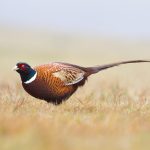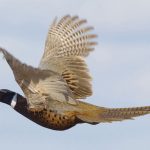Ruffed Grouse Forecast 2018 Traveling Wingshooter
The buzz in the upland gamebird world is coming out of one of the Lake States, and it has to do with a buzzing insect. Turns out the much-anticipated increase in the ruffed grouse cycle didn’t materialize as expected in the Lake States.
In 2017, the drumming surveys in Wisconsin revealed high grouse populations, including 2.09 grouse per stop in the northern region. The hype was building for a peak in one of the years between 2019 and 2021. However, the Wisconsin ruffed grouse harvest declined from 262,943 in 2016 to 185,336 in 2017. Harvest data from Minnesota and Michigan wasn’t available at press time, but anecdotal reports indicate it was a tough season for grouse hunters across the Lake States, and that may continue because of the combination of the April blizzard, followed by torrential rains in some places at nesting time. The 2018 spring drumming surveys revealed a 34-percent decline in Wisconsin and a similar drop in Minnesota. Michigan no longer conducts drumming surveys.
The downturn led some to speculate that West Nile virus, carried by mosquitoes, is causing population-level impacts to grouse, as research in Pennsylvania indicates with a much smaller grouse population dependent upon lower quality habitat. In a controversial move, the Wisconsin Natural Resources Board voted to reduce the ruffed grouse hunting season by two months, closing on November 30 rather than the scheduled January 31. PDJ’s Steve Smith published an excellent status piece on the West Nile subject; it ran in the July/August 2018 issue, and is also available online at www.pointingdogjournal.com/west-nile-viruss-effects-grouse-woodcock-lake-states.
Al Stewart, Michigan DNR Upland Game Wildlife Specialist and Program Leader, noted that the three states are developing a study to learn more about West Nile Virus exposure and infection in the Lake States. Michigan DNR plans to collect 400 samples from four regions in the northern Lower Peninsula and Upper Peninsula this fall.
In Minnesota, the 2018 drumming survey revealed an average of 1.5 drums per stop statewide, down 29 percent from last year, according to Charlotte Roy, Minnesota DNR. She stated that populations tend to rise and fall on a decade-long cycle and that the counts this year point to the peak lasting only one year this cycle.
In Maine, spring drumming surveys showed improvement over last year’s low, and many of the routes were up substantially from last year, according to Kelsey Sullivan, Maine Department of Inland Fisheries & Wildlife. “Nesting conditions were very good with relatively low precipitation during the nesting season and post-hatch. I expect a good number of grouse this fall.”
It’s a similar story in New York. The drumming survey revealed increased grouse numbers, and it was dry during May-June, which is good for nest and chick success, says Michael Schiavone, New York Department of Environmental Conservation. The flush rate last season was highest in the Catskills-Delaware Hills (about 0.99 grouse flushed/hour) and Appalachian Hills & Plateau (0.92 flushes/hour) ecozones. This spring, the drumming rate increased in the Appalachian Hills & Plateau and Champlain Valley ecozones. Andy Weik of the Ruffed Grouse Society is getting reports of folks seeing lots of birds in the North Woods of northwest Maine, portions of Vermont, and in northern New Hampshire.
In Pennsylvania, the grouse flush rates last season hit a 52-year low, said Lisa Williams, Pennsylvania Game Commission. Williams reports that this spring’s weather was not ideal for brood-rearing and that it could be a bad year for West Nile virus. She expects grouse hunting success to be modest at best.
Kentucky also hit an all-time low with a flush rate of 0.18 grouse flushed per hour of hunting, well off their long-term average of 0.76 flushes per hour, according to Zak Danks, Kentucky Department of Fish and Wildlife Resources. Danks attributes the dismal season to two cold and wet springs and inadequate habitat. “Kentucky’s grouse population continues to suffer from lack of suitable early successional young forest habitat across our eastern counties on the Appalachian Plateau and Mountains.” On the bright side, spring was much warmer and drier, so Danks expects better grouse recruitment in areas of good habitat. Ruffed grouse numbers are at historic lows in Ohio, with hunters recording one flush for five hours afield on average last season, reported Mark Wiley, Ohio DNR.





